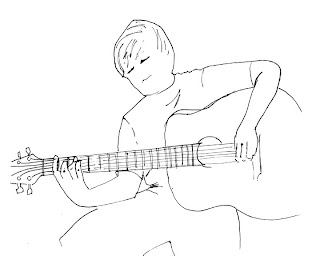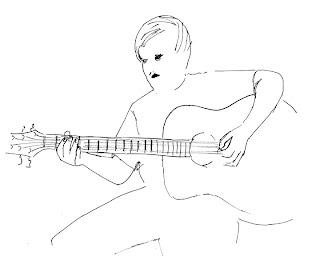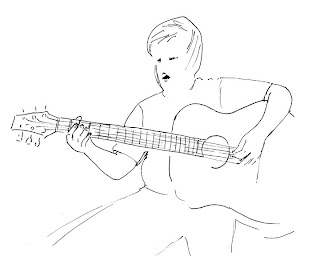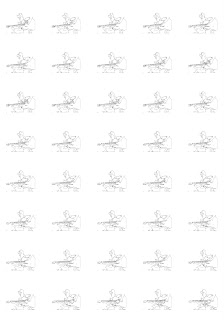I think of all the tests I carried out the most successful was the final live trace as I was able to copy all 29 frames per second and also the line were perfect to the position of the action. Also because the frames were in the same sequence and timing as the original video I was able to synchronise the audio perfectly.
Monday, 25 April 2011
What is a line - Hand Drawn moving image
With this brief I had always intended to do something hand drawn. I feel the digital moving image is far superior to a flip book as you can reinforce the line movement with the audio. I have traced then finished off with hand drawing thirteen images from the Use somebody video. I have run out of time to do anymore at this stage. I have tried to keep the lines as simple as possible. The thirteen images are across 130 frames so I should achieve a 4 or 5 second piece.
The finished moving image was disappointingly poor however what it demonstrates is how important just a single line can be. I had traced the outline to try to get the position and frame correct however just getting the mouth and hairline wrong totally changes the face. If I had more time I think I would try to simplify the line drawing even further to see if this is more effective or even just focus on the hand movements and guitar. Also the video only has 13 frames which is too few to achieve any realistic movement. I would spend more time perfecting the line drawings and do more.
I think of all the tests I carried out the most successful was the final live trace as I was able to copy all 29 frames per second and also the line were perfect to the position of the action. Also because the frames were in the same sequence and timing as the original video I was able to synchronise the audio perfectly.
I think of all the tests I carried out the most successful was the final live trace as I was able to copy all 29 frames per second and also the line were perfect to the position of the action. Also because the frames were in the same sequence and timing as the original video I was able to synchronise the audio perfectly.
Saturday, 23 April 2011
What is a line - Improved process for live trace
By trial and error I have worked out the best way off importing the movie file to jpegs then how to automate live trace using the Adobe Bridge. I have also been playing around with live trace to get a clearer line drawn image. As the first video I used of Oliver was quite zoomed out it picked up loads of details and movement which was quite distracting. To simplify what was in the frame I videoed Oliver much closer so the main movement live trace would pick up were the strumming and chord changes.
If you only need a small number of frames (less than 500) the best method is to use a menu function in Photoshop as follows:
This is preset 5 I have created in illustrator to live trace. I was trying to get as much outline detail as possible but also smoother lines so when I put into a movie the frame did not move around to much. A tip I picked up from a web tutorial is that the blur can be used just a 0.2-.05 of a pixel to smooth out the corners.
Another test what is a line from Lisa Whitaker on Vimeo.
I also experimented with adding block colour to this line video which was only marginally successful as the batch process I used to do this did not colour every photo as I had planned. The colour certainly adds to the form of the image and defines the action more.
If you only need a small number of frames (less than 500) the best method is to use a menu function in Photoshop as follows:
The function enables you to select the section of video you wish to save as jpegs. The file created is a single file with several layers. To convert to single Jpegs the menu option
allows you to convert the layers to single jpegs.
This is preset 5 I have created in illustrator to live trace. I was trying to get as much outline detail as possible but also smoother lines so when I put into a movie the frame did not move around to much. A tip I picked up from a web tutorial is that the blur can be used just a 0.2-.05 of a pixel to smooth out the corners.
Creating PDF contact sheets in the Bridge
Bridge batch live trace
This process produces Illustrator files so following this step the files must be saved as JPEGS. Again in the Bridge using photoshop image processor.
I uploaded these images into Quick player then cut the WAV file for the 15 seconds of the piece I had chosen. I am wondering about experimenting with text following a line across these images.
I think this version of the line video is much more successful as the line defines the arms and guitar more distinctly. This means the action is a lot more defined.
I also experimented with adding block colour to this line video which was only marginally successful as the batch process I used to do this did not colour every photo as I had planned. The colour certainly adds to the form of the image and defines the action more.
Friday, 22 April 2011
What is a line continued development
I experimented with different settings of the Live trace function in Illustrator
Using Photoshop to convert video to jpegs
I pushed the live trace images of Oliver to the simplest lines possible. There is still the shape outline and you can still see movement of the arms however the shapes needs more definition.
Untitled from Lisa Whitaker on Vimeo.
After hand tracing the jpegs I tried the same rotating effect with these live trace jpegs - Did not work very well!
Rotate test from Lisa Whitaker on Vimeo.
After hand tracing the jpegs I tried the same rotating effect with these live trace jpegs - Did not work very well!
Wednesday, 20 April 2011
Speaking from experience -My experience
List 5 things a first year needs to know:
List 5 problems a first year will encounter
- Get a locker, a cup and coffee. Use kettle int he studio and save £10 a week.
- EXPERIMENT - \no-one is interested in what you were good at last year. See what you are good at now.
- Blog everything everyday
- Dob't call the people lecturing 'teachers' they are tutors or lecturers
- Make time for CTS - it will help your design
List 5 problems a first year will encounter
- Managing time (badly)
- Meeting dealines (several at one time)
- Compromising - team/group work essential
- Printing off in the digital dungeaon when you have not planned/booked in
- Giving constructive feedback
- Be on time (ten mins b4 time at least!)
- Attend all briefings,seminars and workshops
- Book appointments with James to print
- Don't eat in the studio
- Remember to still have fun
Tuesday, 19 April 2011
What is a line - Idea development
As well as illustrating the action of Oli playing guitar I have also tried different ways of tracing/creating a line in Illustrator and Photoshop. I worked out how to convert a video file into individual jpegs using Quick Player. /i then manipulated these in firstly in Illustrator and then in Photoshop.
Torn edges
I also experimented with adding the lyrics to the jpegs using the fill pattern feature in Photoshop and also filling the image with colour.
This is a screen shot of the live trace setting
In Illustrator I tried unsucessfully to automate an action to live trace the jpegs ( as I videoed 15 frames per second it takes 900 frames to create a 60 second video!) The action would have to be automated for this many frames, So I settled for a 10 second piece using this method:
I was slightly more sucessful at automating the stylise filter trace contour in Photoshop. I settled on this effect after experimenting with several filters however trace contour gave the best line effect.
Trace Contour
Find edges
Glowing edges
Graphic pen
Ink outline
I also experimented with adding the lyrics to the jpegs using the fill pattern feature in Photoshop and also filling the image with colour.
I tried using the special effects in Final Cut to see if these would be effective at showing the lines. These are the results
I used the above images to try to create a flip book. The paper needed to be slightly thicker and perhaps more images. The white line images did not print out clearly.
I also used a Final cut special effect line art which works reasonably well although does not look hand rendered :
Subscribe to:
Posts (Atom)




























































